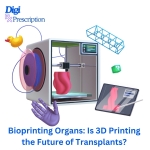Introduction
Imagine a world where organ shortages no longer exist, and patients in need of transplants can receive 3D-printed organs customized to their bodies. Bioprinting, an innovative form of 3D printing using living cells, is making this vision a reality. Scientists are now successfully printing tissues, blood vessels, and even functional organs, revolutionizing the field of organ transplantation.
In this blog, we’ll explore the latest advancements in bioprinting, its challenges, and the future of 3D-printed organs in healthcare.
1. What is Bioprinting?
How Does Bioprinting Work?
Bioprinting is a type of 3D printing that uses bio-inks made of living cells to create functional tissues and organs. The process involves:
1️⃣ Creating a digital blueprint of the organ using MRI or CT scans.
2️⃣ Layer-by-layer printing of bio-ink (stem cells and biomaterials) to form the organ structure.
3️⃣ Culturing the printed organ in a bioreactor to allow cells to mature and function.
Why is Bioprinting Important?
???? Addresses Organ Shortages – Millions of patients are on transplant waiting lists, but bioprinting could eliminate the need for donors.
???? Personalized Medicine – 3D-printed organs can be customized to each patient, reducing rejection risks.
???? Lower Costs – Traditional organ transplants are expensive, while bioprinting could make them more affordable.
2. Recent Successes in Bioprinting Human Organs
Heart Bioprinting Breakthroughs
???? In 2019, researchers at Tel Aviv University successfully 3D-printed a miniature human heart using a patient’s own cells. This was a major step towards printing full-sized functional hearts for transplant.
???? In 2023, scientists bioprinted heart valves that can grow with a patient, reducing the need for multiple surgeries in children.
3D-Printed Livers & Kidneys
???? Wake Forest Institute for Regenerative Medicine has developed 3D-printed liver tissues that mimic real liver functions, paving the way for full-sized liver transplants.
???? Researchers at Harvard University created functional kidney structures using bioprinting, bringing us closer to lab-grown kidney transplants.
3D-Printed Skin for Burn Patients
???? Scientists have developed bioprinted skin grafts that can be directly applied to burn wounds, healing them faster and with minimal scarring.
???? The U.S. Army is funding research on bioprinting skin for injured soldiers on the battlefield.
3. Challenges in Bioprinting Human Organs
Despite its promise, bioprinting still faces significant challenges:
???? Complexity of Organs – While simple tissues have been printed successfully, complex organs like lungs and kidneys require intricate blood vessel networks that are hard to replicate.
???? Cell Survival & Functionality – Ensuring bioprinted organs function like real organs is a major hurdle.
???? Ethical Concerns – Should we be allowed to print human organs on demand? What are the risks of unregulated bioprinting?
???? High Costs & Scalability – Bioprinting is still expensive, and mass production of organs is not yet feasible.
4. The Future of 3D-Printed Organs
???? AI & Machine Learning in Bioprinting – AI is helping scientists design better organ blueprints and predict how cells behave in 3D-printed structures.
???? Stem Cell-Based Organs – Using a patient’s own stem cells to print organs could eliminate transplant rejection risks.
???? Hospitals with Bioprinters – Future hospitals may have on-site bioprinters, allowing doctors to print organs as needed.
???? Global Impact – Bioprinting could democratize healthcare, giving low-income countries access to affordable transplant solutions.
Conclusion
Bioprinting is reshaping the future of organ transplantation, offering hope for millions who suffer from organ failure. With scientific breakthroughs in heart, liver, kidney, and skin bioprinting, we are closer than ever to creating fully functional, transplantable organs.
However, technical, ethical, and financial challenges remain. As technology advances, bioprinting could become a mainstream medical practice, transforming healthcare as we know it.
???? What are your thoughts on bioprinting? Do you think 3D-printed organs should be widely available? Share your opinion in the comments!
References:
- Harvard Medical School – The Future of Bioprinting: www.health.harvard.edu
- Tel Aviv University – 3D-Printed Heart Breakthrough: www.tau.ac.il
- Wake Forest Institute – Bioprinted Liver Research: www.wakehealth.edu
- NIH – The Science Behind Bioprinting: www.nih.gov

